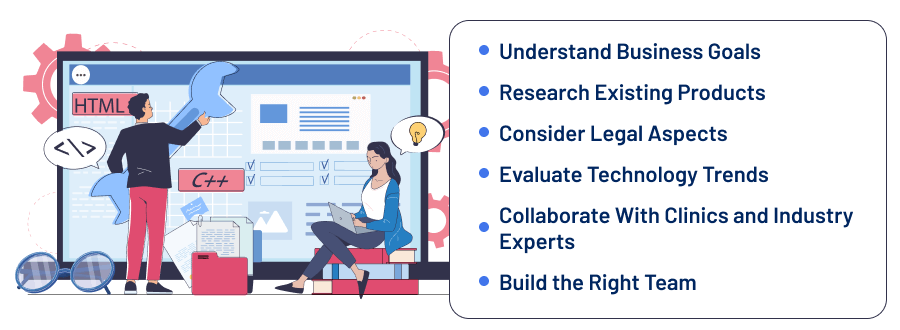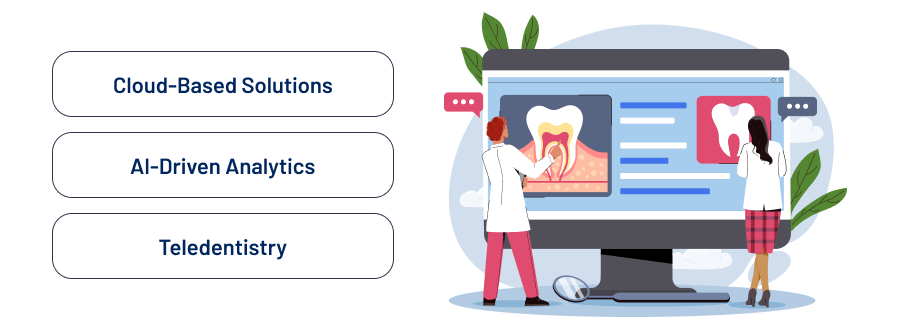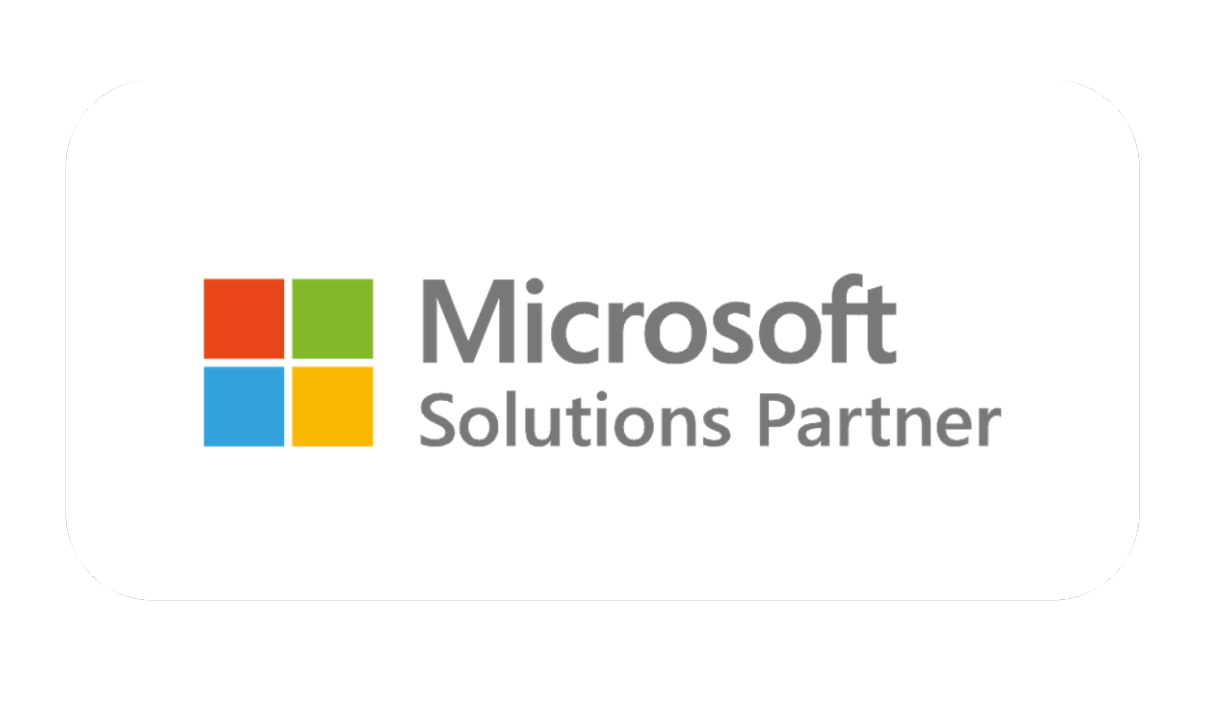How do you think a successful dental practice looks? Effective patient and staff management, streamlined appointment scheduling, personalized treatment plans, seamless billing, and insurance processing probably come to mind first. Sure thing, these are among the main goals of every dental clinic owner.
So, how can you elevate your dental business, making it engaging for both dentists and patients? And, of course, as a business owner, you also want to achieve your own outcomes, right?
If you’re looking for an all-in-one solution to get things done, then start with adding dental practice management software development (DPMS) to your to-do list.
Key Highlights
- DPMS documents every piece of data, such as procedures, payments, and treatment histories, elevating the overall transparency of the dental practice.
- DPMS can accurately process insurance claims, eliminating potential coverage plan mistakes and increasing transparency in decision-making.
- Custom dental practice management software may set you back a lot, but your investment will, undoubtedly, pay off in the future.
- If you are looking for a way to create secure, scalable, and cost-effective dental practice management software, keep an eye on cloud-based solutions.
Consider this: the global dental practice management software market is projected to reach $3.90 billion by 2032. Given the opportunities it opens, this growth should come as no surprise. It means more companies are becoming conscious of the crucial role dental practice management software plays and are ready to invest in it. Hence, if you don’t consider DPMS for your business, you risk losing a lot.
Well, let’s not beat around the bush, and dive in to explore what exactly you should expect from DPMS.
A System That Works for Everyone: When All the Sides Win

So, what is dental software? Probably, you can guess from the name that it’s a platform designed to support clinical care and improve patient management.
Before getting into the detailed discussion about dental practice management solutions, let’s first understand what makes it so valuable. As we’ve already briefly mentioned, to succeed in your dental practice, you should cover the needs of all sides: patient, staff, and your own.
Fortunately, a DPMS is designed with this in mind. And the cornerstone of succeeding in all frontiers lies in the transparency that DPMS brings. This precisely becomes possible by documenting every piece of data, from appointments and procedures to payments and treatment histories. As such, crucial data becomes accessible to all sides.
Let’s get a tad more specific and explore what exactly this transparency for everyone means:
- Business owners: As an entrepreneur, you can use this data to gain a clear understanding of your operations and financial performance. As such, you may offer better services and allocate your budget wisely.
- Staff: Dental practice management systems allow dentists to quickly access patient records, review previous treatments and medical history to provide more accurate and personalized care.
- Patients: Today, people tend to be more health-conscious and want to be actively involved in their treatment plans. DPMS precisely offers that. All the records that are available to dentists are also accessible to clients, giving them transparency on their treatment history, upcoming procedures, payments, and overall health information.
You see, transparency is a cornerstone of DPMS. But, as you might guess, it also offers many other opportunities, from improving the accuracy of diagnostics to simplifying appointment scheduling and customer support. Now, let’s move forward and discuss the core benefits aligned with potential pitfalls of dental practice management solutions in the upcoming chapter.
What to Expect from Your DPMS? Key Pros and Cons to Keep in Mind
When it comes to implementing any solution, everything starts with assessing the key advantages it can bring to a business. Sure thing, when investing in something, you want to get the most out of it. However, wise implementation also requires considering some core pitfalls that you will most likely encounter along the way.
The same is true for DPMS. Though they come with plenty of benefits, there are also some factors to weigh before tapping into implementation. Hence, let’s share a chart to help you quickly assess the core pros and cons that dental practice management solutions can hold.
Pros of DPMS |
Cons of DPMS |
|---|---|
| Increases efficiency by automating administrative tasks (e.g., appointment scheduling, record-keeping, billing, etc.) | DPMS involves integrating multiple modules, meaning the implementation phase can be quite challenging |
| Notably speeds up claim processing and payments | In the beginning, employees may struggle with using the system and require some training |
| Improves customer satisfaction by providing access to medical records | System downtime can disrupt clinical operations |
| Provides reporting and analytics on clinic performance, thus leading to better staff management and revenue growth | Though in the long run DPMS cuts plenty of costs, it may require a significant initial investment |
How to Make Your DPMS Outshine? Key Features to Look For
Once you’ve considered the basic advantages and disadvantages of DPMS, it’s time to think about the core features your solution should have. Of course, depending on your main pain points, the feature set of your product may vary. Yet, based on our experience in developing DPMS, here are the core features we believe a robust dental practice management solution should be centered around:
1. Patient Record Management

Given all the pros highlighted earlier, it should come as no surprise that, first and foremost, your dental management solution should be capable of handling patient records. This allows you to collect clients’ data in one place and make it accessible to all sides.
Let’s emphasize that patient records encompass all kinds of information about a person, such as allergies, diagnoses, appointment and treatment history, and the like. And just picture how hard it may be for your staff to access these piles of documents manually. Meanwhile, the patient record management system is pretty simple to access.
This flexibility and opportunity to have all the required information at their fingertips allow dentists to provide better treatment plans. Needless to say, clients benefit from such a system as well. Specifically, they gain more control over their care and effortlessly check previous procedure records if needed.
DPMS improves patient care in many ways. Specifically, dental practice management software serves as a central hub for all patient records, giving dentists quick, comprehensive access to patient records. It significantly assists in better treatment plan creation. Plus, as there is no need to check all the files manually, it speeds up the process. So, patients may gain personalized treatment as soon as possible.
2. Appointment Scheduling

In the past, patients used to visit the clinic or wait in line to make an appointment through a call. For administrative staff, it also posed some challenges.
When checking available slots manually, there is a high potential for errors. For example, your staff may overlook some available days and inadvertently schedule two patients for the same slot.
Fortunately, DPMS resolves the issue by automating appointment scheduling. Besides increased accuracy, it also saves plenty of precious time for your administrative staff to focus on more important tasks.
Moreover, dental solutions, powered with an appointment scheduling feature, make it possible for patients to check slots independently, set appointments, as well as simply postpone or cancel them. Eventually, this feature allows sending automated reminders to patients, ensuring they won’t miss the clinic visit.
Find out how we assist our client in streamlining Medical Appointment Scheduling
3. Billing and Payment Processing

The next crucial feature of a dental practice management solution that we can’t overlook is billing and payment. Ideally, it’s a wise move to offer several payment options like credit card, digital, or even crypto wallets. This way, you may simplify patient transactions.
Additionally, it’s worth automating the billing and invoicing process to elevate accuracy. Specifically, your system may generate invoices directly after treatment and send them to patients immediately. As such, your billing records will be both correct and timely.
Do you need payment software development services?
TALK TO US4. Insurance Management System

Dental insurance in the U.S. can be quite complicated. With so many nuances, it’s easy to get lost in the weeds when trying to figure out which services are covered and which are not.
Learn more about how healthcare practices can Verify a Patient’s Insurance Coverage
Let’s say a patient requires a routine dental cleaning, expecting that their insurance will cover all the expenses. Meanwhile, it turns out the insurance only compensates for related procedures like fluoride treatments or preventive exams. A patient felt confused. Administrative staff, on the other hand, was trying to recheck everything.
Manually checking all coverage documentation is like nailing jelly to the wall. But if your DPMS is capable of integrating with insurance systems, you can automate claim handling. Therefore, achieving faster and more accurate processing. That is to say, you kill two birds with one stone: reduce administrative workload and increase transparency of decision-making.
Check out how we assist a dental insurance consultant in Automating Document Processing
5. Patient Relationship Management

Effective patient relationship management is at the heart of any business, and a dental practice is no exception to this end. To smoothly handle communication with clients and provide excellent customer support, patient relationship management (PRM) systems can serve best.
The power of a PRM lies in its ability to handle all aspects of the patient journey, from initial consultation to follow-ups and retention. In general, they allow you to send reminders for appointments, notify patients about promotions or special offers, and provide updates on treatment plans.
But that is not all the perks patient relationship management systems offer. They can be integrated with CRM systems to track users’ interactions and preferences. This insight will be pretty useful in adjusting your services accordingly and elevating client satisfaction.
You may also consider integrating your PRM systems with AI-powered call centers. First, it can assist your agents in real time, suggesting optimal responses to resolve the conversation in the best possible way.
Besides, smart call centers are capable of deeply analyzing calls. You need this insight to identify the main pain points of your patients to fill gaps. Additionally, these solutions can help track your employees’ performance and offer them feedback for improvement.
Discover how to Elevate Customer Relationship with Velvetel Pulse
Gaining Control of Customer Engagements
What if every customer could deal with your single most effective sales or service person?
6. Inventory Management

Next on our list of must-have features for a robust DPMS is inventory management. Specifically, it assists in tracking stock levels of different items, from masks and sterilizers to dental materials and equipment.
These items are crucial to ensure smooth patient care. And only by constantly tracking your inventory level can you ensure that necessary suppliers are always available for your staff.
See how we built a powerful Inventory Management Solution for a Client
7. Reporting and Analytics

It’s pretty safe to say that without data analytics in place, all your efforts to streamline your dental services and increase revenue may fall short.
In general, analytics can shed light on almost everything you need, whether it’s monitoring patient interactions, assessing staff performance, measuring the effectiveness of your marketing material, and the like. Meaning, your dental practice management solution definitely should include reporting and analytics features.
Discover how BI Can Help Your Big Data Make Sense
Custom solutions are a great choice if your dental practice has specific and unique needs. While off-the-shelf solutions may seem like a cost-effective alternative and can be implemented quickly, they often fall short in meeting your expectations.
Additionally, off-the-shelf products are not always flexible enough to be customized to your exact needs. So, if you require specific features or are sure that your app will need significant customization in the future, opting for a custom solution will save you time, budget, and stress.
Best Practices to Build Better Dental Practice Management Software
As Aristotle aptly noted, “Well begun is half done!” This wisdom is highly applicable to any endeavor aimed at success. Hence, whatever your initiative is, it’s crucial to weigh all the critical nuances beforehand. As such, you may be prepared for potential pitfalls and make a wise start.
Let’s now briefly touch upon the core factors you should consider before diving into your dental practice management solution development.

- Understand business goals: Though it may sound obvious, start by clarifying exactly why you need dentistry software and what main pain points it should solve.
- Research existing products: This way, you may not only understand the key principles of DPMS, but also identify gaps or missing features in existing apps. What else do you need to bring an excellent solution to the table?
- Consider legal aspects: Dealing with patients’ private data necessitates taking steps to safeguard it accordingly. Specifically, you should be well-versed in industry-related regulations and strictly adhere to them.
- Evaluate technology trends: Being aware of current industry trends and assessing how they can enhance your system is a wise move and can help you stay competitive.
- Shortlist core functionalities for MVP: Most likely, you will start with an MVP development to assess the performance and effectiveness of your app. So, before creating it, identify the core features your MVP should be built around.
- Collaborate with clinics and industry experts: Besides merely analyzing existing apps, you can also collaborate with clinics that have already employed DPMS. This can assist in aligning realistic expectations, prioritizing the right features, and preparing for potential challenges. Plus, if possible, try to connect with some industry experts for consultation.
- Build the right team: Having valuable insights is crucial to building a robust dental practice management solution, but it’s impossible without a skilled team in place. Hence, after identifying what kind of solution you need, start building your relevant team.
Expanding a Team
Watch our webinar to unveil the tricks of onboarding a tech partner and incorporating it into the process to foster your product delivery.
Technology Trends to Build a Cutting-Edge Dental Practice Management Software
With so many things being said about dental practice management software, you’ve undoubtedly gained a solid understanding of it. However, our publication would be incomplete without discussing the tech trends in the DPMS market that definitely warrant your attention. So, before wrapping up, let’s round up the core three trends to watch for:

Cloud-Based Solutions
Security, cost-effectiveness, and scalability: these capabilities make cloud-based solutions more than just a buzzword. They are truly valuable for businesses aiming to develop highly secure and effective products without breaking the bank.
See how we improve Dental Onboarding and Underwriting with Cloud Solutions
In addition, cloud-based dental platforms are designed to comply with healthcare industry regulations and security frameworks such as HIPAA, GDPR, and SOC2. Let’s admit, it really takes the burden off your shoulders in ensuring safe and secure data management.
AI-Driven Analytics
As we have already highlighted, dental clinics are becoming more focused on patient needs and excelling in their ability to provide better treatment plans.
All these prominent changes would be impossible without data analytics, with AI at the forefront. The role of AI here is significant, as it helps accurately process huge datasets for better insights. Plus, AI algorithms can elevate the accuracy of X-rays and diagnoses, thus improving the overall quality of dental services.
But that is not the only opportunity AI-driven analytics bring to dentistry. It has caused a real paradigm shift in personalized communication and customer support.
Decades ago, personalized communication might have just meant addressing people by name. All you had to do was change the name of the client in your email template and send the same message. Yet, such kinds of personalization are already a thing of the past.
AI algorithms analyze a person’s communication style and preferences and adjust messages accordingly. Let’s admit, this kind of dialogue can’t slip away unnoticed.
Interested in AI development services?
CONTACT US!Teledentistry
Telemedicine has become quite popular in recent years, and it’s easy to picture how it works. In the dental industry, it’s an emerging trend, yet not everyone can see what the process looks like. While there are limitations for diagnosis, patients can still connect with a dentist quickly in case of emergencies.
Consider that a patient feels sudden tooth pain late at night or when they are in another country. They can reach the doctor via a video call and show the affected tooth and area. This information may be enough for the dentist to provide first aid advice to reduce pain and suggest initial treatment options that can be done at home.
You see, teledentistry has become pretty much possible.
When it comes to healthcare-related product regulations, HIPAA compliance comes first. So, if you are going to provide teledentistry services, make sure you collect, use, and share customer data in alignment with HIPAA regulations. If operating in the EU or providing services to EU customers, you should also adhere to GDPR compliance.
On top of that, to provide reliable teledentistry services, you will need to obtain the proper licensing. This will ensure that you are authorized to practice in the current state or country.
It’s Time to Develop Your Robust Dental Practice Management Software
Wrapping up everything we’ve explored in this publication, the development of your dental practice management software is probably no longer in question. It’s the only way to offer personalized customer support, make your entire dental practice operation transparent, and increase the accuracy of diagnoses.
These are not the entire capabilities of a robust DPMS, but they are core ones that undoubtedly every dental solution should have.
If you require assistance and consultation, Velvetech can serve as a helping hand, providing solid dental software development services.
Give us a call to discuss your pain points and find the perfect solution for your endeavor.
































